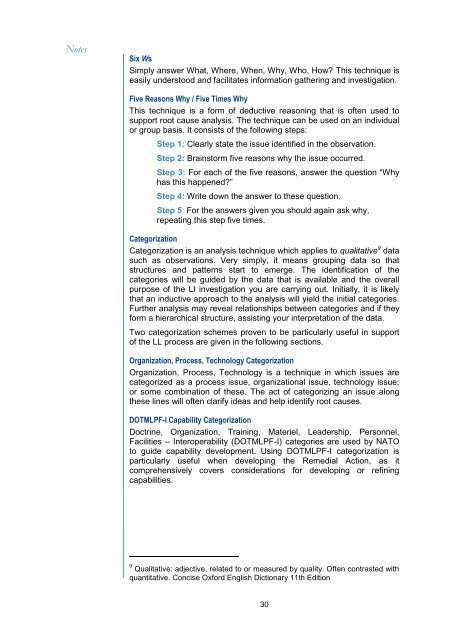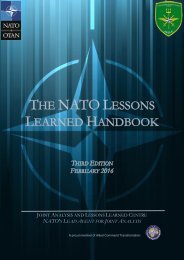JOINT ANALYSIS LESSONS LEARNED CENTRE NATO'S LEAD AGENT JOINT ANALYSIS
1ViofYb
1ViofYb
You also want an ePaper? Increase the reach of your titles
YUMPU automatically turns print PDFs into web optimized ePapers that Google loves.
Notes<br />
Six Ws<br />
Simply answer What, Where, When, Why, Who, How? This technique is<br />
easily understood and facilitates information gathering and investigation.<br />
Five Reasons Why / Five Times Why<br />
This technique is a form of deductive reasoning that is often used to<br />
support root cause analysis. The technique can be used on an individual<br />
or group basis. It consists of the following steps:<br />
Step 1: Clearly state the issue identified in the observation.<br />
Step 2: Brainstorm five reasons why the issue occurred.<br />
Step 3: For each of the five reasons, answer the question “Why<br />
has this happened?”<br />
Step 4: Write down the answer to these question.<br />
Step 5: For the answers given you should again ask why,<br />
repeating this step five times.<br />
Categorization<br />
Categorization is an analysis technique which applies to qualitative 9 data<br />
such as observations. Very simply, it means grouping data so that<br />
structures and patterns start to emerge. The identification of the<br />
categories will be guided by the data that is available and the overall<br />
purpose of the LI investigation you are carrying out. Initially, it is likely<br />
that an inductive approach to the analysis will yield the initial categories.<br />
Further analysis may reveal relationships between categories and if they<br />
form a hierarchical structure, assisting your interpretation of the data.<br />
Two categorization schemes proven to be particularly useful in support<br />
of the LL process are given in the following sections.<br />
Organization, Process, Technology Categorization<br />
Organization, Process, Technology is a technique in which issues are<br />
categorized as a process issue, organizational issue, technology issue;<br />
or some combination of these. The act of categorizing an issue along<br />
these lines will often clarify ideas and help identify root causes.<br />
DOTMLPF-I Capability Categorization<br />
Doctrine, Organization, Training, Materiel, Leadership, Personnel,<br />
Facilities – Interoperability (DOTMLPF-I) categories are used by NATO<br />
to guide capability development. Using DOTMLPF-I categorization is<br />
particularly useful when developing the Remedial Action, as it<br />
comprehensively covers considerations for developing or refining<br />
capabilities.<br />
9 Qualitative: adjective, related to or measured by quality. Often contrasted with<br />
quantitative. Concise Oxford English Dictionary 11th Edition<br />
30



